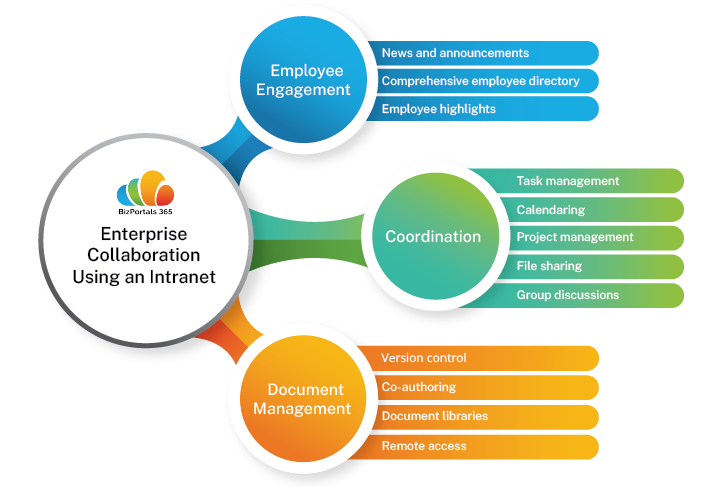Table of Contents
- What Is Enterprise Collaboration?
- The Need for an Enterprise Collaboration Platform
- Highlighting the Remarkable Enterprise Collaboration Benefits
- Exploring BizPortals 365 as an Enterprise Collaboration Solution
Step into a smarter digital workplace
Get a Free Product TourThe constant desire to stay updated with emerging technology has helped businesses overcome the challenges arising out of a rapidly evolving and competitive market. Certainly, scattered documents, difficulty in sharing files, siloed departments, and lack of tasks and document tracking have lowered the overall productivity of the organization.
However, even if you digitize your workplace, what do you think is still missing?
When implementing a digital solution, the primary goal must be to create a collaborative environment for employees and ease the complexity of your business processes. Indeed, a collaborative space where your employees can connect with their coworkers, brainstorm, learn new things, and work together can be revolutionary. Well, this is what enterprise collaboration is all about.
Read on this informative blog covering enterprise collaboration, its benefits, and the role of SharePoint intranet in shaping a successful enterprise collaboration solution.
What Is Enterprise Collaboration?
Enterprise collaboration refers to the process of how employees working together within the enterprise interact with their co-workers as well as the workplace itself. It helps businesses of all sizes to achieve robust operational excellence by facilitating a collaborative environment. As a broader concept, it even includes digital technology that an organization adopts to enable communication, collaboration, and cooperation among employees.
Apart from achieving common goals, enterprise collaboration practices also help you display a strong company culture, safeguard intellectual assets, and create a social platform for employees to interact with.
To get a better grasp of this, let’s examine some of the common challenges organizations face and why enterprise collaboration platforms are necessary.
The Need for an Enterprise Collaboration Platform
Understanding the needs of present-day enterprises is something other than rocket science. The changing workplace dynamics present a myriad of challenges, including remote and hybrid work culture, increased employee turnover, complex workflows, and reduced productivity. Organizations must explore the missing link between employee engagement, employee experience, and workplace productivity to stay ahead. This can help them find the best way to leverage modern digital platforms for enhanced efficiency and productivity. For now, let’s understand in detail some core challenges enterprises face.
1. Disconnected workplaces
Internal communication, the backbone of business processes, ensures adequate flow of information and knowledge within the organization. However, ineffective or complex communication channels cause misunderstandings and restrict information sharing, ultimately leading to uninformed choices. Furthermore, isolated and disconnected employees are less likely to engage, causing barriers to effective teamwork.
2. Scattered documents
Many organizations often use physical storage or network drives to store documents. Finding or accessing scattered documents often causes information retrieval delays that slow down the process, eventually increasing the overall response time. At the same time, the lack of enterprise collaboration makes it challenging for employees to track changes, co-author, and securely work on documents.
3. Uninformed decision making
A less collaborative environment often discourages employees from contributing to the decision-making process. Employees struggling with data overload, departmental silos, and ineffective communication are unable to effectively collaborate and brainstorm together. Indeed, this limits the diversity of ideas, creativity, access to resources, and employees’ ability to contribute innovatively.
4. Lesser employee engagement
The level of employee engagement directly impacts workplace productivity. It’s true that uncollaborative workplaces lead to disengaged employees, which in turn leads to lesser productivity and higher turnover rates. Additionally, a lack of a collaborative platform prevents employees from getting recognized by their organization and coworkers, negatively affecting their morale and happiness at work.
5. Unorganized knowledge
An organization’s intellectual assets include not only key documents but also the experience of its employees. Siloed organizational structure, lack of a centralized platform, and missing enterprise collaboration practices often compartmentalize knowledge on cluttered network drives and unorganized libraries. So, why not systematically organize it?
Here are a few of the primary benefits of enterprise collaboration, and the role modern intranets play in this process.
Highlighting the Remarkable Enterprise Collaboration Benefits
1. Enhanced workforce engagement
Connected employees are effective collaborators and team players. But, despite all the efforts, making employees feel integral to the workplace is often challenging for many organizations. However, creating an engaging and personalized interface for employees where they can access essential news and announcements, socially interact with their co-workers, and share ideas and feedback can imprint a culture of open communication and transparency.
Again, every effort counts when you are aiming for employee engagement. You can use an enterprise collaboration platform to highlight employees’ achievements, recognize their efforts, or wish them birthdays to ensure their advocacy.
2. Uninterrupted internal communication
Uninterrupted communication is the key to creating a collaborative environment. Enterprise collaboration strategy helps you create a platform where employees can connect with each other and share resources and information even from remote settings.
You can create multiple channels and allow employees to use them freely. It can be 1:1 chat, group discussions, and instant meetings that help them transfer knowledge or work together to find an innovative solution to any given problem.

3. Improved coordination and productivity
Workplace productivity refers to the amount of work completed in a specific period of time. However, enterprise collaboration platforms like intranet combine aspects of coordination, internal communication, and technological advancements to streamline different processes. This, in turn, reduces the overall time employees take to perform their job roles efficiently. The added pinch of automation, document management, and employee engagement strategy completes your overall workplace experience.
4. Better document management and control
Document control is undoubtedly the biggest problem that can be solved with an enterprise collaboration solution. Using a centralized and secure space to create, store, and organize information offers advanced document management ability to organizations. However, added features like versioning, multiple permission levels, and co-authoring can provide greater control over your intellectual assets.
5. Faster project completion
It needs unrestricted access to resources, information, and productivity applications to meet your project deadlines. And enterprise collaboration software offers you the same. It brings your teams, documents, and projects together under one roof and helps you set clear and achievable objectives.
Using collaborative planning methods like Kanban boards, dependencies, and Gantt charts can help you streamline your task and project workflows. Furthermore, you can manage and assign tasks and keep track of their status with automated email reminders, thus improving project completion rates.
Exploring BizPortals 365 as an Enterprise Collaboration Solution
Taking it back to the beginning. As businesses navigate the complexities and changing trends of modern workplaces, the urge to use digital workplace technologies is on the rise. And choosing between the available solutions makes it more complex.
However, a flawless enterprise collaboration strategy is certainly something that companies need to pollinate the idea of creating a productive, efficient, and connected workplace environment.
BizPortals 365, a SharePoint-based intranet solution with loads of features, can be a game changer for organizations looking for a centralized, secure, and high-tech solution. With advanced capabilities to manage your documents, teams, departments, tasks, and projects, it helps you efficiently automate and streamline complex workflows, saving time as well as operational costs.
With a range of customization options, BizPortals 365 ensures a seamless enterprise collaboration experience by providing approval workflows, form management, and multiple site templates specifically tailored to your unique industry needs.
Table of Contents
- What Is Enterprise Collaboration?
- The Need for an Enterprise Collaboration Platform
- Highlighting the Remarkable Enterprise Collaboration Benefits
- Exploring BizPortals 365 as an Enterprise Collaboration Solution
Step into a smarter digital workplace
Get a Free Product Tour

